Mostar
| Mostar Mostar/Мостар |
|||
|---|---|---|---|
| — City — | |||
 |
|||
|
|||
 |
|||
| Coordinates: | |||
| Country | |||
| Entity | Federation of Bosnia and Herzegovina | ||
| Canton | Herzegovina-Neretva Canton | ||
| Government | |||
| - Mayor | Ljubo Bešlić (HDZ) | ||
| Area | |||
| - Total | 1,175 km2 (453.7 sq mi) | ||
| Population | |||
| - Total | 128,448 (estimate) (2,007) | ||
| - Density | 89.8/km2 (232.6/sq mi) | ||
| Time zone | CET (UTC+1) | ||
| - Summer (DST) | CEST (UTC+2) | ||
| Postal code | 88000 | ||
| Area code(s) | (+387) 36 | ||
| Website | http://www.mostar.ba/ | ||
Mostar (Latin alphabet, in Cyrillic: Мостар) is a city and municipality in Bosnia and Herzegovina, the biggest and the most important city in the Herzegovina region and the center of the Herzegovina-Neretva Canton of the Federation. Mostar is situated on the Neretva river and is the fifth-largest city in the country. Mostar was named after "the bridge keepers" (natively: mostari) who guarded the Stari Most (Old Bridge) over Neretva river. The Old Bridge was built in the 16th century, during the Ottoman era, and it is one of the city's most recognizable landmarks. The city has the largest population of Croats in Bosnia-Herzegovina.
Contents |
History
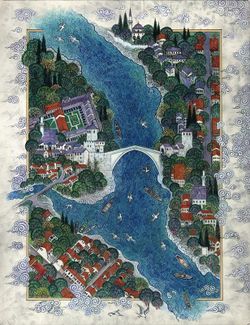
The names of two towns appear in medieval historical sources, along with their later medieval territories and properties – the towns of Nebojša and Cimski grad. In the early 15th century the late medieval county of Večenike covered the site of the present-day Mostar along the right bank of the Neretva: Zahum, Cim, Ilići, Hraštani and Vojno. It was at the center of this area, which in 1408 belonged to the Radivojević's , that Cim fort was built (prior to 1443). Mostar is indirectly referred to in a charter of King Alfonso V of Aragon dating from 1454 as Pons (Bridge), for a bridge had already been built there. Prior to 1444, the Nebojša fort was built on the left bank of the Neretva, which belonged to the late medieval county still known as Večenike or Večerić.[1] The earliest documentary reference to Mostar as a settlement dates from April 3, 1452, when natives of Dubrovnik wrote to their fellow countrymen in the service of Đorđe Branković to say that Vladislav Hercegović had turned against his father and occupied the town called Blagaj and other places, including “Duo Castelli al ponte de Neretua.”.[2]
In 1468 Mostar came under Ottoman rule[2] and the urbanization of the settlement began. Following the unwritten oriental rule, the town was organized into two distinct areas: čaršija, the crafts and commercial centre of the settlement, and mahala or a residential area. In 1468 Mostar acquired the name Köprühisar, meaning fortress at the bridge, at the centre of which was a cluster of 15 houses.[3] In the late 16th century, Mostar was the chief administrative city for the Ottoman Empire in the Herzegovina region. The city's symbol, the "Old Bridge" (Stari Most) is one of the most important structures of the Ottoman era and was built by Mimar Hayrudin, a student of the famous Ottoman architect Mimar Sinan.
The Austro-Hungarian Empire absorbed Mostar in 1878 and it ruled there until the aftermath of World War Iin 1918. The first church in the city of Mostar, a Serbian Christian-Orthodox Church, was built during the Austro-Hungarian rule. In 1881 the town became the seat of the Bishopric of Mostar-Duvno and in 1939, it became a part of the [[Banovina of Croatia].] During World War II Mostar was also an important city in the Independent State of Croatia.
After the World War II, Mostar developed a production of tobacco, bauxite, wine, aircraft and aluminium products. Several dams ("Grabovica", "Salakovac", "Mostar") were built in the region to harness the hydroelectric power of the Neretva. The city was a major industrial and tourist center and prospered economically during the time of the Socialist Federal Republic of Yugoslavia.
Between 1992 and 1993, after Bosnia and Herzegovina declared independence from Yugoslavia, the town was subject to an 18 month siege. The Yugoslav People's Army (JNA) first bombed Mostar on April 3, 1992 and over the following week gradually established control over a large part of the town. By June 12, 1992 the Croatian Defence Council (HVO) and Army of the Republic of Bosnia and Herzegovina (in a joined action) amassed enough strength to force the JNA out of Mostar. The JNA responded with shelling. Amongst the monuments destroyed were a Franciscan monastery, the Catholic cathedral and the bishop's palace (with a library of 50,000 books), a number of secular institutions as well as the Karadžoz-bey mosque, and thirteen other mosques.
In mid June 1992, after the battle line moved eastward, the HVO demolished the Serbian Orthodox Žitomislić Monastery as well as the Saborna Crkva (Orthodox Cathedral Church) that was built in 1863-1873. During the Bosnian War of 1992-95, the Serb Orthodox Cathedral of the Holy Trinity (Serbian: Саборна црква Св. Тројице) and the Church of the Birth of the Most Holy Virgin (Црква Рођења Пресвете Богородице), both dating to the mid 19th century, were demolished by the HVO.[4][5] The cathedral was also known as the New Orthodox Church (Нова православна црква), while the latter was known as the Old Orthodox Church (Стара православна црква). According to the Chairman of the Council of Ministers of Bosnia and Herzegovina, Nikola Špirić, the reconstruction of the cathedral is due to begin in Spring 2008, and will be funded by Prince Charles.[6]
On November 18, 1991, the Croatian Democratic Union (HDZ) branch in Bosnia and Herzegovina, proclaimed the existence of the Croatian Republic of Herzeg-Bosnia, as a separate "political, cultural, economic and territorial whole," on the territory of Bosnia and Herzegovina. Mostar was divided into a Western part, which was dominated by the Croat forces and an Eastern part where the Army of the Republic of Bosnia and Herzegovina was largely concentrated. After the war, the ICTY accused the Croatian Republic of Herzeg-Bosnia leadership for the crimes against humanity and other war crimes during the war, including the destruction of the Stari Most bridge.
Reconstruction
Since the end of the wider war in 1995, great progress is being made in the reconstruction of the city of Mostar. The city was under direct monitoring from a European Union envoy, several elections were held and each nation was accommodated with regard to political control over the city. Over 15 million dollars has been spent on restoration.
A monumental project to rebuild the Old Bridge to the original design, and restore surrounding structures and historic neighbourhoods was initiated in 1999 and mostly completed by Spring 2004. The money for this reconstruction was donated by Spain (who had a sizeble contingent of peacekeeping troops stationed in the surrounding area during the conflict), the United States, Turkey, Italy, the Netherlands, and Croatia. A grand opening was held on July 23, 2004 under heavy security.
In parallel with the restoration of the Old Bridge, the Aga Khan Trust for Culture and the World Monuments Fund undertook a five-year long restoration and rehabilitation effort in historic Mostar.[7] Realizing early on that the reconstruction of the bridge without an in-depth rehabilitation of the surrounding historic neighbourhoods would be devoid of context and meaning, they shaped the programme in such a way as to establish a framework of urban conservation schemes and individual restoration projects that would help regenerate the most significant areas of historic Mostar, and particularly the urban tissue around the Old Bridge. The project also resulted in the establishment of the Stari Grad Agency which has an important role in overseeing the ongoing implementation of the conservation plan, as well as operating and maintaining a series of restored historic buildings (including the Old Bridge complex) and promoting Mostar as a cultural and tourist destination. The official inauguration of the Stari grad Agency coincided with the opening ceremony of the Bridge.[8]
In July 2005, UNESCO finally inscribed the Old Bridge and its closest vicinity onto the World Heritage List.
Demographics
The political control of the ethnically divided city is shared between Croats and Bosniaks. Most of the Mostar's Serbs have been forced from the town during the war, while very few remained. Since the end of the war, the city has been governed under a carefully elaborated policy of national equality. The Croat and Bosniak ethnic communities each claim one side of the main street, and even support for the local football clubs, Velež and Zrinjski, is divided along ethnic lines.
1981
1991
- Muslims by nationality - 43,930 (34.85%) [9]
- Croats - 42,648 (33.83%)
- Serbs - 23,909 (18.97%)
- Yugoslavs - 12,654 (10.04%)
- others - 2,925 (2.32%)
- Total - 126,066
Economy
Mostar`s economy relies heavily on the Aluminium and metal industry, agricultural production, stone manufacturing and tourism. The private sector has seen a notable increase in small and medium enterprises over the past couple of years contributing to the positive business climate. A number of major international banks have their branch offices in Mostar. Considering the fact that three dams are situated on the city of Mostar’s territory, the city has a solid base for further development of production. There is also an ongoing project for the possible use of wind power and building of windmills[10].
Prior to the 1991-1995 war Mostar relied on other important companies which had been closed, damaged or downsized. They included SOKO - military aircraft factory, Fabrika duhana Mostar - tobacco industry, Hepok - food industry. In 1981 Mostar's GDP per capita was 103% of the Yugoslav average [11]
The only company from the former Yugoslavia, which still works well is Aluminij. Aluminij is one of the country's strongest companies and it has a number of international partners. The company steadily increases its annual production and it collaborates with leading global corporations such as Daimler Chrysler and Fiat[12].
Mostar also hosts the annual "International Economy Fair" ("Međunarodni sajam gospodarstva") which was first held in 1997. The Fair consist of several smaller sections: "The Economy Fair ", "Wine Fair", "Book Fair" and "Food Day".
City government
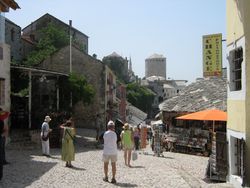
The City of Mostar has the status of a municipality. The city government is led by the Mayor. The current Mayor of Mostar is Ljubo Bešlić (HDZ). The City Council is composed of 35 representatives, coming from the following political parties:
- Croatian Coalition 13
- Croatian Democratic Union (HDZ)
- United Croatian Party of Rights (UHSP)
- Croatian Party of Rights (HSP)
- Croatian Christian Democratic Union (HKDU)
- Croatian People's Union (HNZ)
- Party of Democratic Action (SDA) 10
- Social Democratic Party (SDP) 4
- Party for Bosnia and Herzegovina 4
- People's Party Work for Betterment 1
- Croatian Coalition 1
- Croatian Party of Rights (HSP)
- Croatian Pure Party of Rights (HČSP)
- Independent 2
2008 constitutional crisis
According to the constitution, imposed by High Representative Paddy Ashdown on January 28, 2004 after local politicians failed to reach an agreement, the mayor of Mostar has to be elected by the city council with 2/3 majority.[13][14] Ashdown abolished the six municipalities that were divided equally among Bosniaks and Croats and replaced them with six electoral units.[15] Ridding Mostar of duplicate institutions and costs.[16] In the process Ashdown also reduced the number of elected officials from 194 to 35.[15] According to the constitution the constitutive nations of Bosnia and Herzegovina (Bosniaks, Croats, and Serbs) are guaranteed a minimum of four seats and a maximum of 15 seats.[15] 18 deputies are elected by the election units (3 deputies from each district and 15 deputies are elected at the level of entire city.[14] This move was opposed by the Party for Democratic Action (SDA) and the Croatian Democratic Union (HDZ).[15]
In October 2008, there were elections for the city council. Relative winners were HDZ BiH with the greatest number of votes. However, neither party had enough votes to ensure election of the mayor from their party. The city council met 16 times without success. OHR is also involved, but without success. At last Ljubo Bešlić, running as a candidate of Croatian Democratic Union, was reelected as a mayor.
In a January 26 poll organized by the international community, 75 percent of Mostar’s citizens said that they support the idea of a unified city. Some 83 percent said that they believed that no one ethnic group should rule the city, and 81 percent said that unification should have been accomplished long ago.[15]
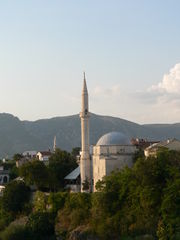
Culture
The city excels in the spheres of art, cuisine, music, theater, museums, and literature. The city is the birthplace of many famous authors, including Aleksa Santic, Ivan Zovko, Predrag Matvejevic, Himzo Polovina, and Grga Martic. Mostar is also widely celebrated in popular lore, featured frequently as the setting for books, movies, and television programs. Dani Matice Hrvatske is one of city's significant cultural events and it is commonly sponsored by the Croatian Government and the Government of the Federation of Bosnia and Herzegovina. Mostar Summer is another umbrella event which includes "Santic Poetry Evenings "," Mostar Summer Festival "and" Festival of Bosnia and Herzegovina choirs / ensembles ". The city is a home of music festival called "Melodije Mostara" (Mostar Melodies) which has been held annually since 1995. Theatre festivals include Mostarska Liska (organized by the Croatian National Theatre) and The International Festival of Author Poetics (Organized by the Mostar Youth Theatre). Mostar Art institutions include:
- Hrvatski dom "Herceg Stjepan Kosaca"
- Culture Center "Mostar
- "Abrasevic" Youth Center
- Music Center "Pavarotti-Mostar"
- Croatian National Theatre Mostar (HNK)
- National Theatre (Narodno Pozoriste)
- Mostar Youth Theatre
- Herzegovina Archive(also known as the county archive)
- Herzegovina Museum
- "Aluminij" Art Gallery
- "Herceg Stjepan Kosaca" Library
- Children's library
- "Luka" Library
- Aleksa Santic House
- Mostar Choir
Architecture
Mostar has architecturally noteworthy buildings in a wide range of styles. Though Mostar was officially part of the Ottoman Empire until the third quarter of the nineteenth century, all of the territories that would later become Bosnia and Herzegovina enjoyed an unusual measure of independence in the eighteenth and most of the nineteenth centuries. Historicist architectural styles reflected cosmopolitan interest and exposure to foreign aesthetic trends and were artfully merged with indigenous styles. Examples include the Italianate Franciscan church, the Ottoman Muslibegovica house, the Dalmatian Corovica House and an Orthodox church which was built as gift from the Sultan.
The Ottomans used monumental architecture to affirm, extend and consolidate their colonial holdings. Administrators and bureaucrats – many of them indigenous Bosnians who converted to Islam – founded mosque complexes that generally included Koranic schools, soup kitchens or markets.
During the period of Austro-Hungarian rule (1878–1918), Mostar’s city council cooperated with the Austro-Hungarians to implement sweeping reforms in city planning: broad avenues and an urban grid were imposed on the western bank of the Neretva, and significant investments were made in infrastructure, communications and housing. City administrators like Mustafa Mujaga Komadina were central players in these transformations, which facilitated growth and linked the eastern and western banks of the city. Noteworthy examples of Austro-Hungarian architecture include the Municipality building, which was designed by the architect Josip Vancas from Sarajevo, Residential districts around the Rondo, and the Gymnasium from 1902 designed by Franc Blazek.
Between 1948 and 1974 the industrial base was expanded with construction of a metal-working factory, cotton textile mills, and an aluminum plant. Skilled workers,both men and women, entered the work force and the social and demographic profile of the city was broadened dramatically; between 1945 and 1980, Mostar’s population grew from 18,000 to 100,000.
Because Mostar’s eastern bank was burdened by inadequate infrastructure, the city expanded on the western bank with the construction of large residential blocks. Local architects favored an austere modernist aesthetic, prefabrication and repetitive modules. Commercial buildings in the functionalist style appeared on the historic eastern side of the city as well, replacing more intimate timber constructions that had survived since Ottoman times. In the 1970s and 1980s, a healthy local economy fueled by foreign investment spurred recognition and conservation of the city’s cultural heritage. An economically sustainable plan to preserve the old town of Mostar was implemented by the municipality, which drew thousands of tourists from the Adriatic coast and invigorated the economy of the city. The results of this ten-year project earned Mostar an Aga Khan Award for Architecture in 1986.[17]
The oldest single arch stone bridge in Mostar, the Kriva Cuprija ("Sloping Bridge"), was built in 1558 by the Ottoman architect Cejvan Kethoda. It is said that this was to be a test before the major construction of the Stari Most began. The Old Bridge was completed in 1566 and was hailed as one of the greatest architectural achievement in the Ottoman controlled Balkans. This single-arch stone bridge is an exact replica of the original bridge that stood for over 400 years and that was designed by Hajrudin, a student of the great Ottoman architect Sinan. It spans 28.7 meters of the Neretva river, 21 meters above the summer water level. The Halebija and Tara towers have always housed the guardians of the bridge and during Ottoman times were also used as storehouses for ammunition. The arch is a perfect semicircle 8.56 m in width and 4.15 m in height. The frontage and vault are made of regular stone cubes incorporated into the horizontal layers all along the vault. The space between vault, frontal walls and footpath is filled with cracked stone. The bridge footpath and the approaching roads are paved with cobblestones, as is the case with the main roads in the town. Stone steps enable people to ascend to the bridge either side.
The Cejvan Cehaj Mosque, built in 1552, il the oldest mosque in Mostar. Later a madrasah (Islamic school) was built on the same compound. The Old Bazaar, Kujundziluk is named after the goldsmiths who traditionally created and sold their wares on this street, and still sells authentic paintings and copper or bronze carvings of the Stari Most, pomegranates (the natural symbol of Herzegovina) or the famed stecaks (medieval tombstones).
The Koski Mehmed pasa Mosque, built in 1617 is open to visitors. Visitors may enter the mosque and take photos free of charge. The minaret is also open to the public and is accessible from inside the mosque. Just around the corner from the mosque is the Tepa Market. This has been a busy marketplace since Ottoman times. It now sells mostly fresh produce grown in Herzegovina and, when in season, the figs and pomegranates are extremely popular. Local honey is also a prominent specialty, being produced all around Herzegovina.
Cuisine
Mostar cuisine is balanced between Western and Eastern influences. Traditional Mostar food is closely related to Turkish, Middle Eastern and other Mediterranean cuisines. However, due to years of Austrian rule and influence, there are also many culinary influences from Central Europe.[18]
Some of the famous dishes include Ćevapčići, Burek, Sarma, Japrak, Musaka, Dolma, Sudžuk, Sač, Đuveč, and Sataraš. Famous local desserts include Baklava, Hurmašice, Sutlijaš, Tulumbe, Tufahije, and Šampita.
Education
Mostar has a number of educational institutions. These include University of Mostar, Džemal Bijedić University, United World College in Mostar, nineteen high-schools and twenty four elementary schools[19]. High-schools include sixteen vocational schools and three Gymnasiums[20].
University of Mostar is the only Croatian university outside the Republic of Croatia. Its predecessor was a Franciscan theology school established in 1895. Dzemal Bijedic University evolved after Mostar acquired several educational departments and after it gained independence from the Univesrsity of Sarajevo in 1977. Despite the substantial destruction of university buildings and the general danger to students and teachers, the University did not interrupt their activities throughout the war (1992–1995).
Sports
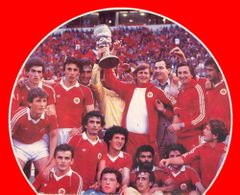
The most popular sport in Mostar is football. The two most successful teams are FK Velež Mostar and HŠK Zrinjski Mostar. Both teams compete in the Premier League of Bosnia and Herzegovina. Since the Bosnian War each club has generally been supported by a particular ethnic group (Zrinjski for the Croats and Velež for the Bosniaks). The matches between the two clubs are some of the country's most intense matches.
Bijeli Brijeg Stadium and Vrapčići Stadium are the city's two main football grounds.
In basketball, HKK Zrinjski Mostar competes at the nation's highest level while the Zrinjski banner also represents the city in the top handball league.
Tourism
Mostar is an important tourist centre in the country. Mostar International Airport serves the city. Mostar's old city is an important tourist destination with the Stari Most being its most recognizable feature. The "Rondo shopping centre", and the "Mercator shopping mall" are some of the city's newer attractions. The Catholic pilgrimage site of Međugorje is also nearby.
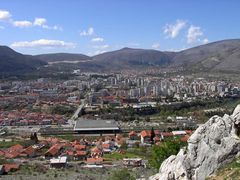
See also
- Tourism in Bosnia and Herzegovina
- Serbs in Mostar
References
- ↑ Anđelić, 1974, 276-278
- ↑ 2.0 2.1 Mujezinović, 1998, p. 144
- ↑ Institute for Regional Planning, Mostar, 1982, p. 21
- ↑ ICTY indictment against the Croat Herzeg-Bosnia leadership, Statement of the Case, Article 27, 2003.
- ↑ Prof. Michael Sells' page documenting the destruction
- ↑ Шпирић: Tреба се окренути будућности да би сви заједно успјели
- ↑ "Conservation and Revitalisation of Historic Mostar - AKTC" (PDF). http://www.akdn.org/hcsp/mostar.pdf. Retrieved 2006-11-15.
- ↑ "Resurgence of Mostar’s Historic City Centre". http://www.akdn.org/news/mostar_230704.html. Retrieved 2006-11-29.
- ↑ http://www.fzs.ba/Dem/Popis/Nacionalnost%20opcine%20Popis%201991.pdf
- ↑ Kamerić Sanela , Jakovac Josip. "Welcome to Mostar". Balkans on the Web. 24/08/2010 http://www.balkansontheweb.net/city.php?Mostar
- ↑ Radovinović, Radovan; Bertić, Ivan, eds (1984) (in Croatian). Atlas svijeta: Novi pogled na Zemlju (3rd ed.). Zagreb: Sveučilišna naklada Liber.
- ↑ http://www.aluminij.ba/About_us-Partners.htm
- ↑ http://www.index.hr/vijesti/clanak/ashdown-nametnuo-novi-ustroj-mostara/183132.aspx
- ↑ 14.0 14.1 http://www.ohr.int/decisions/mo-hncantdec/default.asp?content_id=31708
- ↑ 15.0 15.1 15.2 15.3 15.4 http://www.isn.ethz.ch/isn/Current-Affairs/Security-Watch/Detail/?ots591=4888CAA0-B3DB-1461-98B9-E20E7B9C13D4&lng=en&id=107315
- ↑ http://www.ohr.int/ohr-dept/presso/pic/mostar-one-city/default.asp?content_id=31689
- ↑ Pasic, Amir. Conservation and Revitalization of Historic Mostar. Geneva: The Aga Khan Trust for Culture, 2004.
- ↑ Tim Clancy, Bosnia & Herzegovina, The Bradt Travel Guide, 2004, pp. 93–97, ISBN 1-84162-094-7 Darra Goldstein; Kathrin Merkle, Fabio Parasecoli, Stephen Mennell, Council of Europe. Directorate General IV-Education, Culture and Heritage, Youth and Sport. Culinary cultures of Europe: identity, diversity and dialogue. Council of Europe. pp. 87–94 . ISBN 9287157448. http://books.google.com/books?id=1Dz0srxxDFoC
- ↑ http://www.bljesak.info/content/view/37733/158/
- ↑ http://www.mostarinfo.net/mostar/opce_informacije/srednje_skole
External links
- Virtual Tour/360° Panoramas - Mostar
- Visit Mostar
- City of Mostar
- http://www.sallybecker.co.uk/
- Mostar International Airport
- - Mostar Spring 2009
- National Monument- Muslibegovica House
- Pictures of Mostar 2004
- Photos of Mostar and Old Bridge
- Ultimate guide to Mostar
- Bridge opens but Mostar remains a divided city, The Guardian, July 23, 2004
- War documentary about besieged East Mostar, the bloodiest place in Herzegowina during the Bosnian War.
- Photos and spherical panoramas of Mostar
- "A Short History of Mostar" - published in Conservation and Revitalisation of Historic Mostar
|
|||||||
|
||||||||||||||||||||||||||||||||||||||||||||||||||||||||||

